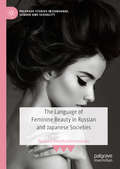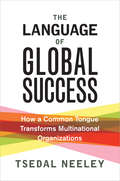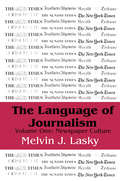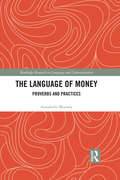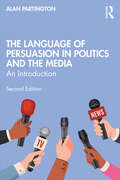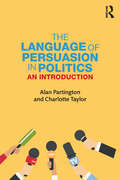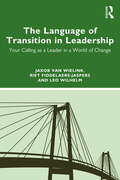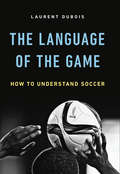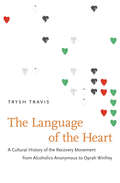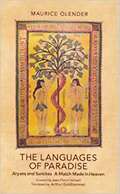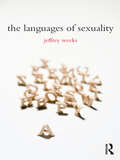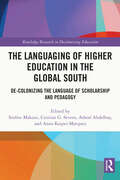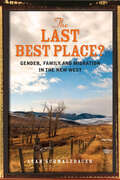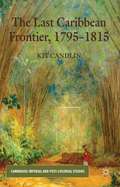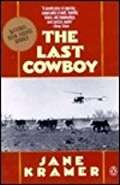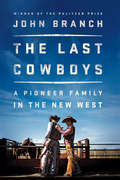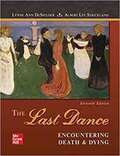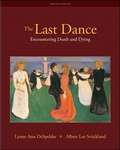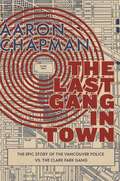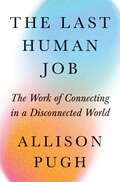- Table View
- List View
The Language of Contention
by Sidney TarrowThis book examines the relations between the material and political bases of contentious politics and the construction, diffusion and endurance of contentious language. Beginning with the language of revolution developed from the seventeenth to the nineteenth centuries, it examines contentious language at work, in gender and race relations and in nationalist and ethnic movements. It closes with an examination of emotions in contentious politics, reflecting on the changes in political language since 9/11 and assessing the impact of religion and recent innovations in electronic communication on the language of politics.
The Language of Feminine Beauty in Russian and Japanese Societies (Palgrave Studies in Language, Gender and Sexuality)
by Natalia KonstantinovskaiaThis book conducts a cross-linguistic and cross-cultural study of 'women’s language' as it pertains to feminine beauty. It examines the ideological constructs of beauty and femininity in the cultures of Japan and Russia, as embodied through televised beauty ads, and relates them to the real-world language practices of Japanese and Russian women. The author traces the reciprocal connection between women’s real and imagined language in the construction of ideals of beauty and femininity, revealing the complex ways women respond to ideological expectations regarding language use: assimilating, transforming, and subverting ideologized language and the assumptions implicit in it. She also demonstrates ways in which women alter the texture of language by appropriating 'masculine' language for their own purposes, shifting the meaning and correlates of linguistic items and structures. This book will be of interest to students and scholars of sociolinguistics, language and gender, cultural and media studies, and Russian and Japanese culture.
The Language of Global Success: How a Common Tongue Transforms Multinational Organizations
by Tsedal NeeleyFor nearly three decades, English has been the lingua franca of cross-border organizations, yet studies on corporate language strategies and their importance for globalization have been scarce. In The Language of Global Success, Tsedal Neeley provides an in-depth look at a single organization—the high-tech giant Rakuten—in the five years following its English lingua franca mandate. Neeley’s behind-the-scenes account explores how language shapes the ways in which employees who work in global organizations communicate and negotiate linguistic and cultural differences.Drawing on 650 interviews conducted across Rakuten’s locations in Brazil, France, Germany, Indonesia, Japan, Taiwan, Thailand, and the United States, Neeley argues that an organization’s lingua franca is the catalyst by which all employees become some kind of “expat”—someone detached from their mother tongue or home culture. Through her unfettered access to the inner workings of Rakuten, she reveals three distinct social groups: “linguistic expats,” who live in their home country yet have to give up their native language in the workplace; “cultural expats,” or native speakers of the lingua franca, who struggle with organizational values that are more easily transmitted after language barriers are removed; and finally “linguistic-cultural expats,” who, while native to neither the lingua franca nor the organization’s home culture, surprisingly have the easiest time adjusting to language changes. Neeley demonstrates that language can serve as the conduit for an unfamiliar culture, often in unexpected ways, and that there are lessons to be learned for all global companies as they confront language and culture challenges.Examining the strategic use of language by one international corporation, The Language of Global Success uncovers how all organizations might integrate language effectively to tap into the promise of globalization.
The Language of Journalism: Volume 1, Newspaper Culture (Language Of Journalism Ser.)
by Melvin J. LaskyThe newspaper is to the twentieth century what the novel was for the nineteenth century: the expression of popular sentiment. In the first of a three-volume study of journalism and what it has meant as a source of knowledge and as a mechanism for orchestrating mass ideology, Melvin J. Lasky provides a major overview. His research runs the gamut of material found in newspapers, from the trivial to the profound, from pseudo-science to habits of solid investigation.The volume is divided into four parts. The first attacks deficiencies in grammar and syntax with examples from newspapers and magazines drawn from the German as well as English-language press. The second examines the key issues of journalism: accuracy and authenticity. Lasky provides an especially acute account of differences between active literacy and passive viewing, or the relationship of word and picture in defining authenticity.The third part emphasizes the problem of bias in everything from racial reporting to cultural correctness. This is the first systematic attempt to study racial nomenclature, identity-labeling, and literary discrimination. Lasky follows closely the model set by George Orwell a half century earlier. The final section of the work covers the competition between popular media and the redefinition of pornography and its language. The volume closes with an examination of how the popular culture both influenced and was influential upon literary titans like Hemingway, Lawrence, and Tynan.
The Language of Mediums and Psychics: The Social Organization of Everyday Miracles
by Robin WooffittEvery week thousands of people in Europe and the USA consult psychic practitioners. Communication is crucial to the performance of psychic powers in a range of settings. Psychic practitioners use language to demonstrate their powers, whether they are reporting the words of their spirit contacts or interpreting the spread of Tarot cards. Their clients also accept or reject this information through talk. This book presents the first sustained study of the verbal interaction between the various kinds of psychic practitioners and their clients. Using conversation analysis, Robin Wooffitt examines the structure of the interaction, focusing on the ways in which psychic practitioners and their clients establish the authenticity of the claimed paranormal powers. Adopting a neutral standpoint towards the status of the claims of psychic practitioners, the book raises important issues about the role of social science in understanding the activities of psychic practitioners and other kinds of parapsychological phenomena. This highly original study will appeal to students and scholars of discourse studies, and to sociologists interested in conversation analysis. It is written in a style accessible to non-specialists, and will also interest parapsychologists and social scientists studying psychic phenomena and the paranormal.
The Language of Money: Proverbs and Practices (Routledge Research in Language and Communication)
by Annabelle MooneyThrough a detailed examination of proverbs related to money, this book offers a comprehensive critique of the prevailing everyday ideologies and discourses on money and paves the way toward establishing a new set of proverbs more conducive to financial equality and human well-being. The volume explores a variety of contexts to demonstrate the different aspects of the money system and the linguistic and social structures embedded within them, including pay day loan websites, gambling, get rich self-help books, and new forms of currency. Unpacking this complex relationship between people, money, and language in contemporary society, this book is an ideal resource for students and scholars in language and communication, sociolinguistics, rhetoric, sociology, and media studies.
The Language of Persuasion in Politics and the Media: An Introduction
by Alan PartingtonThis bestselling introductory textbook examines the relationship between politicians, the press and the public through the language they employ. Now fully revised with new material on delegitimisation, ‘fake news’, disinformation, (self-)censorship, ‘conspiracy theories’ and ‘Zombie’ narratives, key topics include:• Evaluation, the ‘engine’ of persuasion.• ‘Spin’, ‘spin control’ and ‘image’ politics.• Models of persuasion, including authority, contrast, problem-solution, association, ‘garden path.’• Pseudo-logical and ‘post-truth’ arguments.• Humour, irony and satire.• Metaphors: use, misuse and dangers.• Election rhetoric.Extracts from speeches, soundbites, newspapers and blogs, social media, interviews, press conferences, election slogans and satires are used to provide the reader with the tools to discover the beliefs, character and hidden strategies of the would-be persuader, as well as the counter-strategies of their targets. This book demonstrates how the study of language use can help us appreciate, exploit and protect ourselves from the art of persuasion.With a wide variety of practical examples, on both recent issues and historically significant ones, every topic is complemented with guiding tasks, queries and exercises, with keys and commentaries at the end of each unit. This highly original textbook is ideal for all introductory courses on language and politics, media language, rhetoric and persuasion, discourse studies and related areas.
The Language of Persuasion in Politics: An Introduction
by Charlotte Taylor Alan PartingtonThis accessible introductory textbook looks at the modern relationship between politicians, the press and the public through the language they employ, with extensive coverage of key topics including: ‘spin’, ‘spin control’ and ‘image’ politics models of persuasion: authority, contrast, association pseudo-logical and ‘post-truth’ arguments political interviewing: difficult questions, difficult answers metaphors and metonymy rhetorical figures humour, irony and satire Extracts from speeches, soundbites, newspapers and blogs, interviews, press conferences, election slogans, social media and satires are used to provide the reader with the tools to discover the beliefs, character and hidden strategies of the would-be persuader, as well as the counter-strategies of their targets. This book demonstrates how the study of language use can help us appreciate, exploit and protect ourselves from the art of persuasion. With a wide variety of practical examples on both recent issues and historically significant ones, every topic is complemented with guiding tasks, queries and exercises with keys and commentaries at the end of each unit. This is the ideal textbook for all introductory courses on language and politics, media language, rhetoric and persuasion, discourse studies and related areas.
The Language of Transition in Leadership: Your Calling as a Leader in a World of Change
by Jakob van Wielink Leo Wilhelm Riet Fiddelaers-JaspersIn this book, the authors utilise their decades of experience in leadership and coaching for change to help leaders develop the necessary skills to lead people and organisations in transition. Combining a scientific and practice-based approach, they show readers how to develop and maintain their own impactful leadership style while creating psychological safety in their teams. Leadership that achieves sustainable results comes from connecting past, present and future. Describing leadership as a journey, the book invites the reader to discover their calling and realise the importance of examining the roots of their leadership, before thinking about its destination. It gives leaders access to a new dimension of unprecedented growth and demonstrates the ways these lessons and skills can transform change into lasting transitions. Accessible and written in a lively style, The Language of Transition in Leadership is an important book for leaders and executives. It will also be of interest to coaches, organisational advisors, management consultants, students of leadership and those transitioning into the workforce.
The Language of the Game: How to Understand Soccer
by Laurent DuboisJust in time for the 2018 World Cup, a lively and lyrical guide to appreciating the drama of soccer Soccer is not only the world's most popular sport; it's also one of the most widely shared forms of global culture. The Language of the Game is a passionate and engaging introduction to soccer's history, tactics, and human drama. Profiling soccer's full cast of characters--goalies and position players, referees and managers, commentators and fans--historian and soccer scholar Laurent Dubois describes how the game's low scores, relentless motion, and spectacular individual performances combine to turn each match into a unique and unpredictable story. He also shows how soccer's global reach makes it an unparalleled theater for nationalism, international conflict, and human interconnectedness.Filled with perceptive insights and stories both legendary and little known, The Language of the Game is a rewarding read for anyone seeking to understand soccer better.
The Language of the Heart: A Cultural History of the Recovery Movement from Alcoholics Anonymous to Oprah Winfrey
by Trysh TravisInThe Language of the HeartTrysh Travis explores the rich cultural history of Alcoholics Anonymous (AA) and its offshoots and the larger "recovery movement" that has grown out of them. Moving from AA's beginnings in the mid-1930s as a men's fellowship that met in church basements to the thoroughly commercialized addiction treatment centers of today, Travis chronicles the development of recovery and examines its relationship to the broad American tradition of self-help, highlighting the roles that gender, mysticism, and print culture have played in that development. Travis draws on hitherto unexamined materials from AA's archives as well as a variety of popular recovery literatures. Her analysis traces AA's embrace of the concept of alcoholism as disease, the rise of feminist sobriety discourse and the codependence theories of the 1970s and 80s, and Oprah Winfrey's turn-of-the-millennium popularization of metaphysical healing. What unites these varied cultures of recovery, Travis argues, is their desire to offer spiritual solutions to problems of gender and power. Treating self-help seekers as individuals whose intellectual and aesthetic traditions are worth excavating,The Language of the Heartis the first book to attend to the evolution and variation found within the recovery movement and to treat recovery with the attention to detail that its complexity requires.
The Languages Of Paradise: Aryans And Semites A Match Made In Heaven
by Arthur Goldhammer Maurice OlenderMichel Foucault observed that "the birth of philology attracted far less notice in the Western mind than did the birth of biology or political economy." In this penetrating exploration of the origin of the discipline, Maurice Olender shows that philology left an indelible mark on Western visions of history, and contributed directly to some of the most horrifying ideologies of the twentieth century.
The Languages of Sexuality
by Jeffrey WeeksWords, Freud once wrote, are magic. Nowhere have words been more magical than in the writing of sexuality. Through words and concepts we learn what is good or bad, pleasurable or painful, significant and insignificant. The terms we use about sexuality do not simply describe something out there. They help shape what sexuality is. The Languages of Sexuality offers concise and incisive essays on key words and concepts which have played a significant role in shaping our understanding of contemporary sexualities and intimacies. Nearly a hundred essays illuminate the terms related to sexuality in fresh, and often unexpected ways, with entries ranging from ‘abjection’ and ‘abortion’ to ‘transgender and ‘Viagra’. Written with clarity, insight and passion by an internationally renowned theorist of sexuality, this book is not only an invaluable handbook, but also a personal exploration of the fluid, shifting, ever evolving meanings of sexual life as reflected and refracted through words and concepts. This book is an invaluable resource for both students and researchers with interests relating to sexuality and intimate life, gender studies, cultural studies, history and sociology. It will also appeal to a wider audience interested in critical debates about the nature and meanings of contemporary sexualities.
The Languages of the Jews
by Bernard SpolskyHistorical sociolinguistics is a comparatively new area of research, investigating difficult questions about language varieties and choices in speech and writing. Jewish historical sociolinguistics is rich in unanswered questions: when does a language become 'Jewish'? What was the origin of Yiddish? How much Hebrew did the average Jew know over the centuries? How was Hebrew re-established as a vernacular and a dominant language? This book explores these and other questions, and shows the extent of scholarly disagreement over the answers. It shows the value of adding a sociolinguistic perspective to issues commonly ignored in standard histories. A vivid commentary on Jewish survival and Jewish speech communities that will be enjoyed by the general reader, and is essential reading for students and researchers interested in the study of Middle Eastern languages, Jewish studies, and sociolinguistics.
The Languaging of Higher Education in the Global South: De-Colonizing the Language of Scholarship and Pedagogy (Routledge Research in Decolonizing Education)
by Sinfree Makoni Anna Kaiper-Marquez Cristine G. Severo Ashraf AbdelhayBy foregrounding language practices in educational settings, this timely volume offers a postcolonial critique of the languaging of higher education and considers how Southern Epistemologies can be used to further the decolonization of post-secondary education in the Global South. Offering a range of contributions from diverse and minoritized scholars based in countries including South Africa, Rwanda, Sudan, Qatar, Turkey, Portugal, Sweden, India and Brazil, The Languaging of Higher Education in the Global South problematizes the use of language in various areas of higher education. Chapters demonstrate both subtle and explicit ways in which the language of pedagogy, scholarship, policy, and partcipiation endorse and privelege Western constructs and knowledge production, and utilize Southern theories and epistemologies to offer an alternative ways forward – practice and research which applies and promotes Southern epistemologies and local knowledges. The volume confronts issues including integrationism, epistemic solidarity, language policy and ideology, multilingualism, and the increasing use of technology in institutions of higher education. This innovative book will be of interest to researchers, scholars, and postgraduate students in the fields of higher education, applied linguistics, and multicultural education. Those with an interest in the decolonization of education and language will find the book of particular use.
The Last Best Place? Gender, Family, and Migration in the New West
by Leah SchmalzbauerSouthwest Montana is beautiful country, evoking mythologies of freedom and escape long associated with the West. Partly because of its burgeoning presence in popular culture, film, and literature, including William Kittredge's anthology The Last Best Place, the scarcely populated region has witnessed an influx of wealthy, white migrants over the last few decades. But another, largely invisible and unstudied type of migration is also present. Though Mexican migrants have worked on Montana's ranches and farms since the 1920s, increasing numbers of migrant families—both documented and undocumented—are moving to the area to support its growing construction and service sectors. The Last Best Place? asks us to consider the multiple racial and class-related barriers that Mexican migrants must negotiate in the unique context of Montana's rural gentrification. These daily life struggles and inter-group power dynamics are deftly examined through extensive interviews and ethnography, as are the ways gender structures inequalities within migrant families and communities. But Leah Schmalzbauer's research extends even farther to highlight the power of place and demonstrate how Montana's geography and rurality intersect with race, class, gender, family, illegality, and transnationalism to affect migrants' well-being and aspirations. Though the New West is just one among many new destinations, it forces us to recognize that the geographic subjectivities and intricacies of these destinations must be taken into account to understand the full complexity of migrant life.
The Last Caribbean Frontier, 1795�1815
by Kit CandlinThe Southern Caribbean was the last frontier in the Atlantic world and the most contested region in the Caribbean during the Age of Revolution. As well as illuminating this little-understood region, the book seeks to complicate our understanding of the Caribbean, the role of 'free people of colour' and the nature of slavery.
The Last Cowboy
by Jane KramerPortrays the life of a man who strives to be "a proper cowboy" despite radical changes which have propelled the Old West into a New Southwest characterized by industrialized agribusiness.<P><P> 'The West that Henry mourned belonged to the Western movie, where the land and the cattle went to their proper guardians and brought a fortune in respect and power. It was a West where the best cowboy got to shoot the meanest outlaw, woo the prettiest schoolteacher, bed her briefly to produce sons, and then ignore her for the finer company of other cowboys - a West as sentimental and as brutal as the people who made a virtue of that curious combination of qualities and called it the American experience.' From the Introduction: Henry Blanton is the 'last cowboy' of Jane Kramer's classic portrait, the failed hero of his own mythology, the man who ends an era for himself. His story - his flawed, funny, and in the end tragic efforts to be a proper cowboy, 'expressin' right' in a world where the range is a feed yard and college boys run ranches from air-conditioned Buicks -is the story of a country coming of age in great promise and greater disappointment. A hundred and fifty miles up the highway from agri-business Amarillo, Henry claimed the extravagant prerogatives of a free man on a horse. He rode his own frontier, decked out in his vigilance and his honour, until the shocking moment when in the person of Henry Blanton the West and the Western had a showdown.<P> Winner of the National Book Award
The Last Cowboys: A Pioneer Family In The New West
by John BranchA gripping portrait of one family’s gamble that rodeo and ranching are the future of the West—and not just its past. For generations, the Wrights of southern Utah have raised cattle and world-champion saddle-bronc riders—some call them the most successful rodeo family in history. Now Bill and Evelyn Wright, parents to 13 children and grandparents to many more, find themselves struggling to hang on to the majestic landscape where they’ve been running cattle for 150 years as the West is transformed by urbanization, battered by drought, and rearranged by public-land disputes. Could rodeo, of all things, be the answer? In a powerful follow-up to his prize-winning, best-selling first book, New York Times reporter John Branch delivers an epic and intimate family story deep in the American grain. Written with great lyricism and filled with vivid scenes of ranch life and the high drama of saddle-bronc competition, The Last Cowboys chronicles three years in the life of the Wrights, each culminating in rodeo’s National Finals in Las Vegas. Will Bill and Evelyn be able to hold the family together as rodeo injuries pile up and one of their sons goes off on a religious mission? Will their son Cody, a two-time world champion, make it to the finals one last time—and compete with his own son? And will the younger generation—Rusty, Ryder, Stetson, and the rest—be able to continue the family’s ways in the future? This is a grand and compelling work of reporting that, like Buzz Bissinger’s Friday Night Lights, offers deep insight into American ritual and tradition. And in telling the Wright family’s story, from branding days to rodeo nights to annual Christmas gatherings, Branch captures something vital of the grit, determination, and integrity that fuel the American Dream. An unforgettable book by one of the finest reporters of our time, The Last Cowboys is a moving tribute to an American way of life.
The Last Dance: Encountering Death and Dying
by Albert Lee Strickland Lynne Ann DeSpelder Jeanette M. Potts Marion MasonThe Last Dance: Encountering Death and Dying provides a comprehensive, up to date, and readable introduction to the study of death and dying. It directs attention to the evolving understanding of death and dying in today's culturally diverse environment. In a straightforward, conversational style, with an extensively illustrated format, The Last Dance provides a solid grounding in theory and research as well as in methods for applying what is learned to readers' own circumstances, both personal and professional. No other textbook so successfully combines the research and theories of such diverse disciplines as anthropology, art, ethics, health science, literature, philosophy, psychology, public policy, religion, and sociology. The eleventh edition of The Last Dance includes coverage of key topics yet retains the focus, writing, and pedagogy instructors have come to expect from the best-selling text in death studies.
The Last Dance: Encountering Death and Dying (Ninth Edition)
by Albert Lee Strickland Lynne Ann DespelderThe best-selling textbook in its field, The Last Dance offers an interdisciplinary approach to the study of death and dying. Integrating the experiential, scholarly, social, individual, emotional, and intellectual dimensions of death and dying, this acclaimed text provides solid grounding in theory and research, as well as practical application to students' lives. The ninth edition has been updated to offer cutting-edge and comprehensive coverage of death studies.
The Last Dropout: A Model for Creating Educational Equity
by Bill MillikenA revised and updated edition of an exploration into the foundational principles, impact, and real-life success stories from Communities In Schools.Since 1977, Communities In Schools (CIS) has reached more than one million students and their families annually approximately 3,000 American schools, surrounding them with a community of support and empowering them to stay in school and achieve in life.In The Last Dropout, CIS founder Bill Milliken offers nine key principles that Communities In Schools has tested over four decades. Interwoven are his real-world life stories, a journey that began in the turbulent 1960s as a youth worker and evolved into a handful of groundbreaking "Street Academies" that became the CIS movement with a national network of hundreds of local affiliates. Milliken also shares transformative stories about how CIS leaders have adopted these principles in their own communities, with stunning results.Milliken's guiding philosophy has been "It is relationships, not programs, that change children," and it is a principle that has served as a beacon in the movement for educational equity and success.
The Last Gang in Town
by Aaron ChapmanDecades before organized crime syndicates brought sensational drug wars to Vancouver, street gangs held sway over its unruly east side. None was considered tougher or more feared than the Clark Park gang, a wild, two-fisted crew of characters from Vancouver's post-1960s counterculture. In 1972, after a number of headline-making riots and clashes with police―including an infamous altercation outside a Rolling Stones concert―the Clark Parkers became the target of a secret undercover police squad. Their hostile interactions culminated in a notorious police shooting, resulting in the death of a Clark Park gang member. Combining meticulous research with a keen flair for storytelling, The Last Gang in Town features previously unpublished photos and police documents, as well as testimonials by surviving gang members and police officers who speak for the first time on the subject. The book is a compelling portrait of early-1970s Vancouver and an intriguing and sensational history that puts the spotlight on the after-dark underbelly of the city's not-so-distant criminal past.
The Last Great War
by Adrian GregoryWhat was it that the British people believed they were fighting for in 1914–18? This compelling history of the British home front during the First World War offers an entirely new account of how British society understood and endured the war. Drawing on official archives, memoirs, diaries and letters, Adrian Gregory sheds new light on the public reaction to the war, examining the role of propaganda and rumour in fostering patriotism and hatred of the enemy. He shows the importance of the ethic of volunteerism and the rhetoric of sacrifice in debates over where the burdens of war should fall as well as the influence of religious ideas on wartime culture. As the war drew to a climax and tensions about the distribution of sacrifices threatened to tear society apart, he shows how victory and the processes of commemoration helped create a fiction of a society united in grief.
The Last Human Job: The Work of Connecting in a Disconnected World
by Allison J. PughA timely and urgent argument for preserving the work that connects us in the age of automationWith the rapid development of artificial intelligence and labor-saving technologies like self-checkouts and automated factories, the future of work has never been more uncertain, and even jobs requiring high levels of human interaction are no longer safe. The Last Human Job explores the human connections that underlie our work, arguing that what people do for each other in these settings is valuable and worth preserving.Drawing on in-depth interviews and observations with people in a broad range of professions—from physicians, teachers, and coaches to chaplains, therapists, caregivers, and hairdressers—Allison Pugh develops the concept of &“connective labor,&” a kind of work that relies on empathy, the spontaneity of human contact, and a mutual recognition of each other&’s humanity. The threats to connective labor are not only those posed by advances in AI or apps; Pugh demonstrates how profit-driven campaigns imposing industrial logic shrink the time for workers to connect, enforce new priorities of data and metrics, and introduce standardized practices that hinder our ability to truly see each other. She concludes with profiles of organizations where connective labor thrives, offering practical steps for building a social architecture that works.Vividly illustrating how connective labor enriches the lives of individuals and binds our communities together, The Last Human Job is a compelling argument for us to recognize, value, and protect humane work in an increasingly automated and disconnected world.

